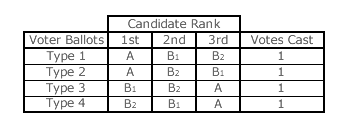Evaluations: Clones, Teaming and Independence Criteria 3
Strategic Nominations
A strategic nomination occurs when a decision to submit or withhold the nomination of a candidate in an election is based on a conscious strategy of attempting to manipulate the contest and change the result. As the earlier irrelevant alternative examples in this section demonstrate, without further information about the context of any real world election, it is generally impossible to tell whether any particular nomination is sincere or strategic. Hence, whatever the real motivation, otherwise valid candidate nominations cannot be rejected.
Where two or more candidates are identical and no voter can distinguish between them when attempting to rank them, such candidates are known as clones. Other separate independent sets of clones may also exist. There are no sincere reasons in theory for two entirely identical candidates to compete against each other for just one seat. Where there are more clones (in a given clone set) than vacancies to be filled, then clearly the excess candidates are nominated for purely strategic reasons. Therefore, mathematical analysis of strategic nominations tends to focus on clones and their influence upon outcomes. In practice, two candidates are never fully identical so are never perfect clones. Nevertheless, strategic nominations pose a very real threat and some voting systems are more vulnerable to cloning than others.
Independence of Clones
A voting system is independent of clones if the addition or deletion of any clone does not change the winner or winners of the election. If any winning candidate is replaced by one of its own clones then this does not matter. As each is a clone of the other, the same identical result occurs so the system is still independent of clones. Before deciding whether CHPV or GV meets this criterion, several issues relating to cloning must first be addressed.
Cloning and its Effects
Consider a straightforward contest between candidates A and B where there are only four voters. If two voters prefer A and the other two prefer B, then the result is tied. Predicting this outcome, suppose that B introduces a clone to gain advantage over A. This CHPV election uses preference weightings of 4, 2 and 1.

Although the voters cannot distinguish between the two B clones B1 and B2, they could all arbitrarily rank B1 ahead of B2 as shown in the table opposite. The candidate tallies (T) generated are as stated below.
- TA = (2x4)+(0x2)+(2x1) = 10
- TB1 = (2x4)+(2x2)+(0x1) = 12
- TB2 = (0x4)+(2x2)+(2x1) = 6
The nomination strategy of B has been successful in getting one of its clones elected. The effect of this type of cloning is called teaming. On the ballots giving B first preference, the B clones have 'teamed up' to 'bury' A; namely, to push A from its second preference position into third place hence lowering the relative tally for A and breaking the tie in favour of B.

However, as voters cannot distinguish between the B clones they could just as easily and arbitrarily rank B1 ahead of B2 in half the ballots and the other way round in the other half as shown in the table opposite. This random choice between the perfect B clones is in fact the most likely scenario. The candidate tallies (T) would then be as stated below.
- TA = (2x4)+(0x2)+(2x1) = 10
- TB1 = (1x4)+(2x2)+(1x1) = 9
- TB2 = (1x4)+(2x2)+(1x1) = 9
This time, the nomination strategy of B has backfired and let A through to win. This type of cloning shares the weightings equally between the two identical candidates and, relative to the non-clone, reduces their resultant (and identical) tally. This 'spoiler' effect is usually called vote splitting. Vote splitting is the default CHPV scenario when the ranking of clones by voters is random. To successfully team against A, B must influence its supporters to prefer one of its clones consistently over the other.
Proceed to next page > Evaluations: Clones & Teaming 4
Return to previous page > Evaluations: Clones & Teaming 2
